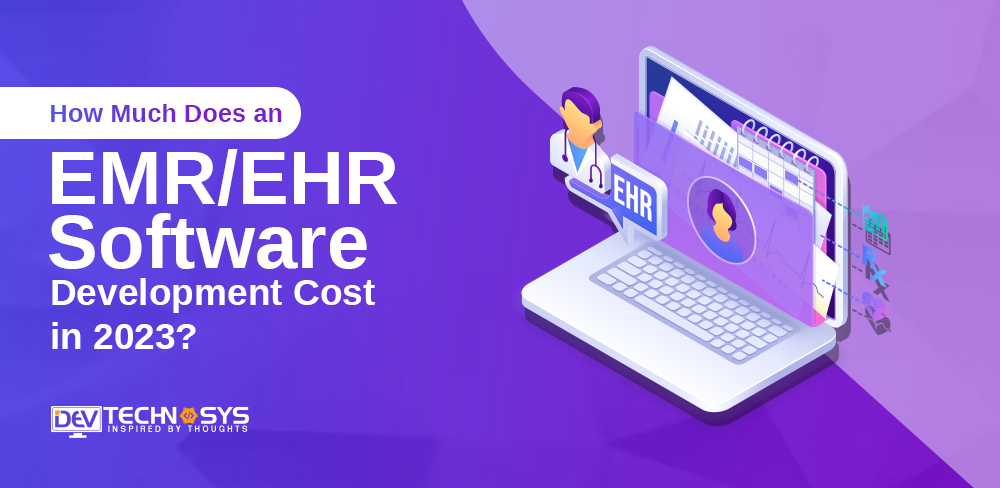Are you looking for EHR software development? Then you must read this blog. The healthcare sector has always been quite open to technology advancements in the business. However, the industry has resisted embracing Electronic Medical Records (EMR) in one area.
The healthcare sector has often been on the slower side when it comes to implementing EMRs because of the high cost and lack of knowledge about the systems. The advantages of EMR, however, much exceed the more expensive installation expenses.
Globe News Wire’s report estimates that Electronic Health Records Software, which was valued at $14,22 billion in 2022 will grow at a CAGR of 9.1% between 2023-2030. According to the same report, North America accounted for the highest revenue contributor to the global market of electronic records software. Europe was not far behind.
EHR systems are highly demanded because they save time and ensure security, as important documents can be lost or damaged. EHR systems are in high demand because they facilitate data sharing between healthcare providers and patients. By automating routine tasks, will improve medical care quality and efficiency.
Below in this blog, we will be looking at EHR software development cost and its essential features and other aspects.
So, let’s get started.
What is an EHR System?

The digital health record (or EHR) is a collection of health information. The EHR includes all the information you’d find in a paper chart plus much more. A EHR may include past medical histories and vital signs, as well as progress notes.
The EHR may also include diagnoses, vaccination dates, allergy, laboratory data and imaging reports. EHRs can also contain other relevant information, such as demographics or insurance data.
However, with the aid of machine learning techniques, it is possible to monitor patients’ Electronic Health Record (EHR) data over a period of time, allowing for the prediction of their susceptibility to various diseases. Machine learning development has improved the accuracy of medical diagnosis and the prediction of potential health risks.
EMR/EHR Software Market

- In 2022, the market for electronic medical records was estimated at USD 28.1 billion. From 2023 to 2030 it is expected to grow at a CAGR of 4.1%. Government initiatives to encourage the use of health IT are driving this industry.
- The market for electronic medical record systems is expected to reach $12.5 billion by 2023.
- The market for Electronic Medical Records Systems has grown by 3.8% per year in the US between 2018 and 2023.
EHR and EMR Difference
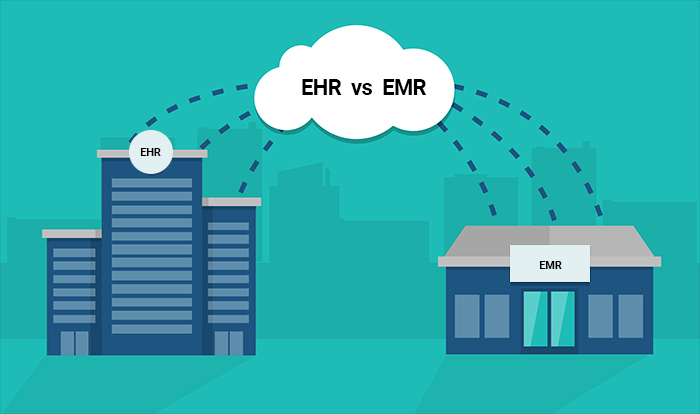
Now the main question arises “what is emr” and “what is ehr”. Well, electronic medical records (EMR), and electronic health records are both digital representations that contain patient health information.
They were designed to improve the standard and effectiveness of healthcare. Although the terms are often used interchangeably they do have some important differences. Here is the main difference between EHRs vs EMRs.
|
Component |
EHR (Electronic Health Record) |
EMR (Electronic Medical Record) |
Scope |
Comprehensive |
Focused on clinical encounters |
Data |
Patient health information |
Patient medical information |
Providers |
Multiple healthcare providers |
Single healthcare provider |
Integration |
Integrated with other systems |
Standalone system |
Accessibility |
Available to authorized users |
Available to one provider and their staff |
Portability |
Can be accessed from multiple locations |
Limited access outside of provider’s office |
Interoperability |
ehr systems can share data with other healthcare systems |
Limited ability to share data with other systems |
Longitudinal Record |
Captures patient health information over time |
Captures patient medical information for a specific encounter |
Note: saas software development has been used in EHR systems for so long as it provides numerous benefits. For instance, convenient management, fast access, cost efficiency in building robust apps.
Essential Features of EHR Software
It would be incorrect to think of an EHR as a simple archive for patient data. EHRs are not only integrated into every aspect of a patient’s life, from the front desk at the clinic to the pharmacy where they receive their medication but also use data analytics to provide important insights.
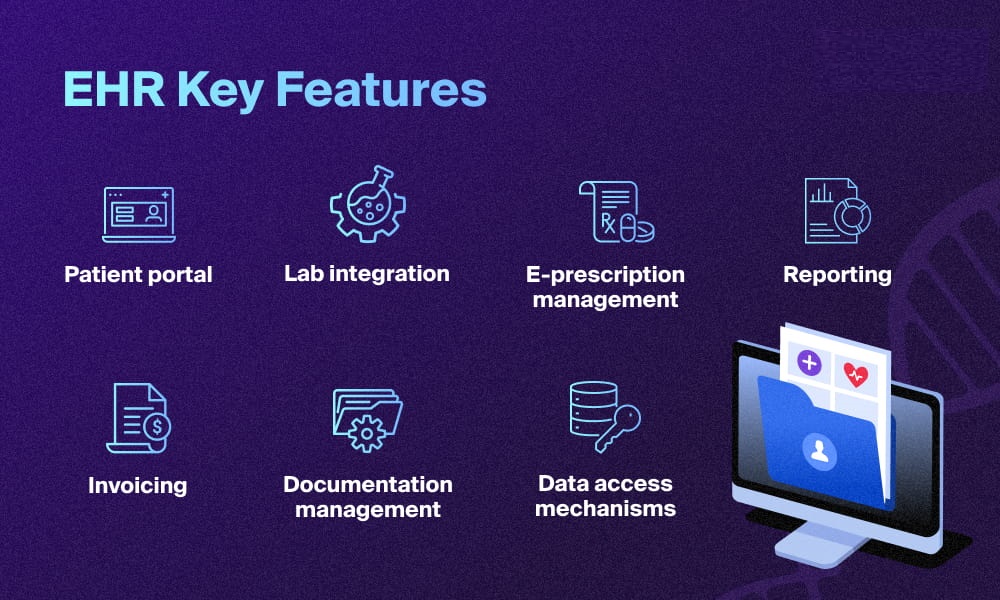
You can find EHR applications for all types of practices, big and small. Most of these solutions have similar features.
● Front-office Unit:
This unit assists administrative staff and clinicians with day-to-day tasks.
1. Automated Scheduling
The EHR app updates the system with the latest appointments.
2. Monitoring Patients’ Status
The EHR software tracks the patients’ journeys, and informs receptionists of their status. This feature allows staff to monitor peak hours and send out wait notifications.
3. Manage Tasks
The EHR also assigns tasks, redirects them and delegates them to other parties and monitors the completion of those tasks.
4. Generating Support Documentation
EHR software can generate clinical documentation, such as individual health plans, guidelines, protocol, etc.
5. Claim Processing
The system tracks the satisfaction levels of clients and allows a clinic to take prompt measures to protect its reputation.
Read More: Mental Health EHR Software Development
● Doctors’ Support Unit:
This EHR helps doctors organize patient records and monitor treatment progress.
1. Digital Chart
The EHR platform gathers all of the information about a specific visitor from hospital charting systems that is available electronically. The record contains the patient’s medical history, personal information, laboratory test results, medical images and drug prescriptions. It can be used as a quick reference. This record also contains the billing and insurance details for a specific person.
2. Voice and Handwriting Recognition
EHR applications allow doctors to enter patient data in a digital chart in a variety of ways. They can fill out electronic forms or speak, and some solutions even recognize handwriting.
3. Generating Reports
EHR solutions can generate reports that target a patient’s treatment plan, clinical notes, and medication lists. Physicians can customize templates depending on their clinical needs and the type of patient visit.
4. Smart Prescriptions
The EHR sends a list of prescription medications to the pharmacy. The system also analyzes drug compatibility and recommends optimal dosages.
5. Alerts
The system informs healthcare companies and their patients of the next steps to be taken, as well as deadlines. The EHR app tracks if a patient is following through with his/her treatment.
6. Data Analytics
The system can identify clients with the most serious health conditions, and provide data to help make decisions.
7. Reporting
EHR systems can report data to the public health registry to monitor the health of the population.
8. Data Segmentation and Tagging
EHR apps allow patients to classify their data and only share certain parts of the medical chart. This protects privacy.
● Billing Unit:
This EHR unit helps manage the financial aspect of patient treatment and gives insights into the clinic’s finances.
1. Generating Invoices
The EHR system generates invoices after each visit. It also compiles and sends the claims to the patient’s insurer and manages denials.
2. Analyzing Revenue and Expenditures
EHR systems provide insights into the financial performance of a medical practice compared with other clinics. They also help monitor revenue streams and identify areas that need restructuring or upgrading.
Benefits of An EHR System
Electronic medical records management software, which is a digital alternative to old-school paper records, greatly simplifies and improves ALL medical practices that are document-related in hospitals, clinics and other facilities.
75% of physicians say that their EHR/EMR helps them deliver better patient care, according to the Office of the National Coordinator of Health Information Technology. Thus, let’s check out the benefits that are given by healthcare app development services providers of EHR systems.

Benefit #1: Superior Convenience in Managing Medical Records
A well-designed emr development system or EHR provides doctors and nursing staff a streamlined data-management experience that is HIPAA compliant:
- Prevents data loss or tampering
- Stop unauthorized users from accessing sensitive data
- Access to your medical records is quick, flexible, and secure.
- Reduced paperwork offers cost-effectiveness
- Avoids duplicate patient records and incorrect input
- All patient-related information is gathered in one place: medical treatment history, laboratory results, health examination reports, etc.
- The most accurate information on patient’s health is available
- It offers a wide range of tools for transparency inpatient service and engagement.
Benefit #2: Enhanced Patient Treatment and Outcomes
EMR/EHR is capable of providing automated information to physicians, nurses, and paramedics. Updated software product development systems will allow doctors to access life-saving notes and cautions when they need the most support in making critical decisions.
- The EHR system will notify the prescriber about any current medication plans, preventing duplicate or conflicting prescriptions.
- If reported side effects or symptoms are detected in a timely fashion, adjustments can be made to the patient’s treatment plan.
- If information about collateral diagnoses or conditions is needed by doctors to adjust treatment/procedure scenarios and medication plans, the appropriate action can be taken.
- Even if the patient is unconscious, emergency department personnel can still learn about life-threatening drug intolerances.
- EHR facilitates a multitude of other complex therapeutic decisions.
Benefit #3: Improved Financial Outcomes for Hospitals and Clinics
The electronic health record can be integrated into a variety of medical emr systems, including patient scheduling, workflows for in-patients, prescriptions, and more. It allows hospitals and clinics the ability to manage their operations more efficiently and benefit from EMR/EHR benefits.
- The healthcare process is coordinated by all departments and organizations. They can refer to synchronized data and coordinate as necessary.
- All medical documents are complete, accurate and organized.
- Medical errors in patient treatment and medication prescription are reduced.
- Automated billing and eligibility verification for insurance is managed smoothly.
- All medical staff and departments use the best evidence-based practices.
- The balance between patient comfort and healthcare provider interests can be achieved by ensuring that the medical services workflow is well organized.
Tech Stack for EHR System
Two factors are responsible for the success of EHRs: the features and the software development company (and technology) that support them. Let’s move on to the second element.
- Java, Python, C# or other programming languages used in EHR software development.
- Frameworks such as Spring Framework, Hibernate, or other frameworks to build web applications.
- Databases: MySQL PostgreSQL Oracle or other relational database.
- Cloud infrastructure: Amazon Web Services, Microsoft Azure, or other cloud platforms to host and scale the software for ehr.
- APIs: Restful APIs to exchange data between medical ehr software systems and other healthcare ehr software systems.
- Tools for privacy and security: Access controls, encryption, and other tools to secure patient data.
How to Build EHR Software?
Now that you know the tech stack for EHR software development, it is time to know the development process. Many entrepreneurs have a question “how to build an ehr system” before they start the development process. Well, it can be quite challenging but following the below stages of development from your EHR software developer can be helpful:
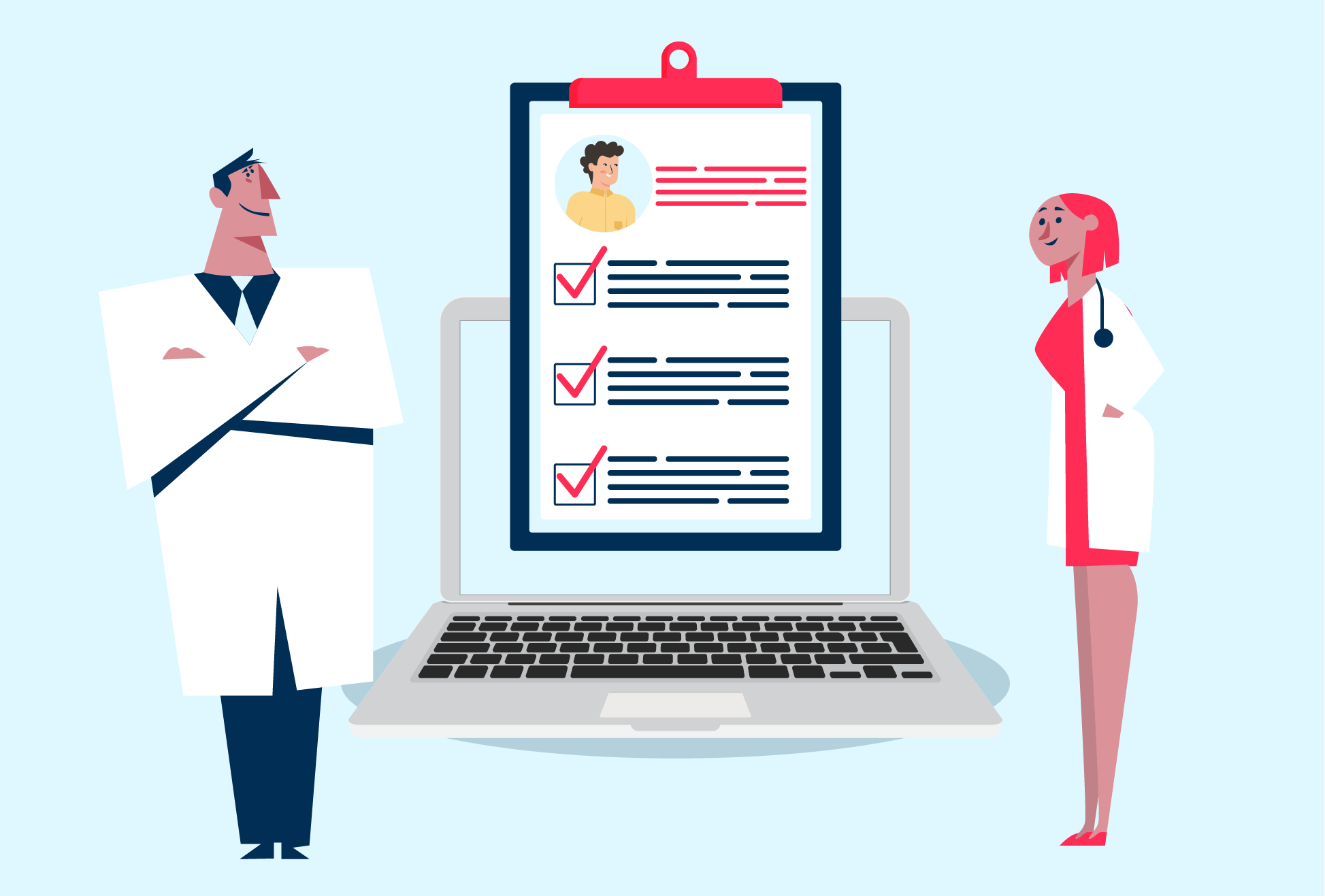
1. Validation of an Idea
The first step of EHR software development is a validation of an idea. The software agency will first examine the feasibility of the solution and its market fit before launching the ehr development software. They will sit down with you to discuss your vision and requirements.
They will also look at your competitors while determining the ehr features you would like to have. The agency will proceed with the design stage after completing a technical and market check on your app.
2. EHR Prototype
The first is to create a list with features. Next, you need to finalize the technology stack and the team that will work on the project. The next step is the EHR software development prototype that closely resembles what the final product will look like and how it will operate.
3. Design, Development and Testing
It begins with the final design process once the team receives approval for the EHR prototype. Wireframes and user experiences are created here, containing the designs that will be seen in the final EHR.
The team will then develop an EHR system that has all the features you need, integrate technologies such as AI, IoT, or Blockchain, and add security. The stages are broken down into agile sprints, which allows for a quicker delivery time and real-time testing of each module.
Also testing of the EHR across multiple platforms, networks and operating systems is necessary to ensure that it is glitch-free and hacker-proof.
4. Launch and Maintenance
Once testing and building the EHR is done, the next step in ehr software development is to launch the software. It either adds to the existing system or launches a brand new one. The deployment experts are crucial in making sure that the launch is smooth. They will maintain ehr emr software to ensure that it is bug-free and continues to work.
How Much Does EMR/EHR Software Cost?
There are many answers to the question “How much does EHR software development cost?”. It can range from zero dollars and one hundred dollars for low-cost software to between $1000 to $5,000 for licensing.
EMR software prices vary widely depending on your requirements and appetite for emerging technology trends like AI and machine learning. You shouldn’t overlook system integration. Cost estimates for EMR implementation vary from $10,000 to $30,000. However, to know the exact cost estimation of EHR software development, you must consult with an ehr software development company.
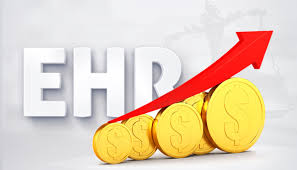
The cost of EMR is determined by several factors. So let’s have a look:
1. Pricing Model
Vendors charge different prices for emr and ehr systems. They also offer different pricing options for you to take into consideration:
- Models such as subscription-based, pay-as-you-go, or pay-per-use: This is a predefined plan that has a set cost and includes EMR features, users, storage space, etc. You will typically pay an upfront fee and then a monthly charge ranging between $200 to $700 for each provider. Chart Logic AdvancedMD and PrognoCIS EMR all use this model.
- Model-based on a pay-per-visit model: The cost depends on the number and frequency of patient visits, ranging from $0.50 up to $1.5 for each visit. This includes usage, maintenance, support, etc. AdvancedMD EHR, and Charm Health EHR are both offering this model.
2. EMR Deployment Type
The cost of EMR integration is largely dependent on the type of deployment. A cloud-based solution is much more affordable than one that uses on-premises software.
- Depending on the cost, you can expect to pay. You also need to invest in maintenance, support, and hardware.
- Cloud-based: You can store data remotely, on the servers of a vendor. This usually requires an annual or monthly license. There are many options: $200/month/user up to $35,000/month. This option does not require significant upfront costs, like on-premises.
3. System Complexity
There are two main categories of adverbs:
- Customization: It includes all adjustments to an EMR purchased in order to meet the needs of your business. It can range from templates for patient notes with custom fields to data analysis. Costs vary depending on how many features are used and by whom.
- Data Migration: You can use this service when you need to export and import data from your current system into a newer one. You can charge a set price or based on the amount of data.
4. Integration
You will have to pay for EMR implementation costs regardless of the ehr system development you use or how it is deployed. You will need to spend between $1,000 and $3,000 on system installation and configuration if you do not have an internal specialist.
Estimate how many devices you will need to purchase before planning EMR Integration if you don’t have hardware like desktop computers, tablet, printers, and scanners.
Conclusion
EMR cost structures are influenced by several factors including pricing models, deployment types, customizations, data migration and integration requirements. You should also consider other hidden costs, such as employee training and staffing. You can choose the EMR that is most cost-effective by carefully analyzing all of these factors.
Now that you know the EHR software development cost, it is time to implement your software development ideas into action. For better results, you can take assistance from a healthcare software development company who will support you in developing a robust EHR software for your business.
Frequently Asked Questions
1. What Are the Things that I Should Keep In Consideration When Building an EHR?
A number of factors can affect the success and continuity of an EHR. Element like its compliance readiness. Its mobile version is available. Please contact our healthcare developers to get a better understanding of these components.
2. How Much Time Does it Take to Build an EHR System?
The length of time required to build a system of electronic health records can vary, depending on factors such as the complexity of that system, the size and needs of an organization. It can take up to 3-4 months for an EHR system to be fully functional.
3. What are the benefits of Telehealth for Pets?
Telehealth, or virtual veterinary care, has several benefits for pets, their owners, and veterinary professionals. Here are some of the main benefits of telehealth for pets:
- Increased Access to Veterinary Care
- Improved Pet Health
- Cost saving
- Time-Saving
4. What Are the Different Types of EHR Systems?
EHR software comes in two types:
- Physician-hosted – This type of EHR is where data is stored on the servers of the physicians.
- Remotely-hosted: In these EHRs the server is located outside of the doctor’s office.
